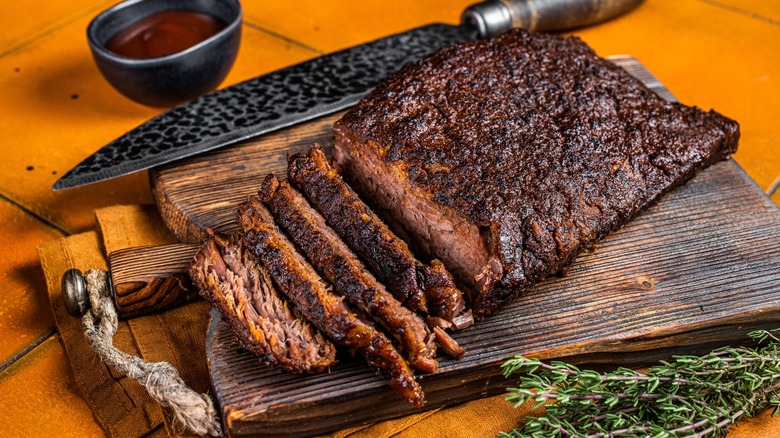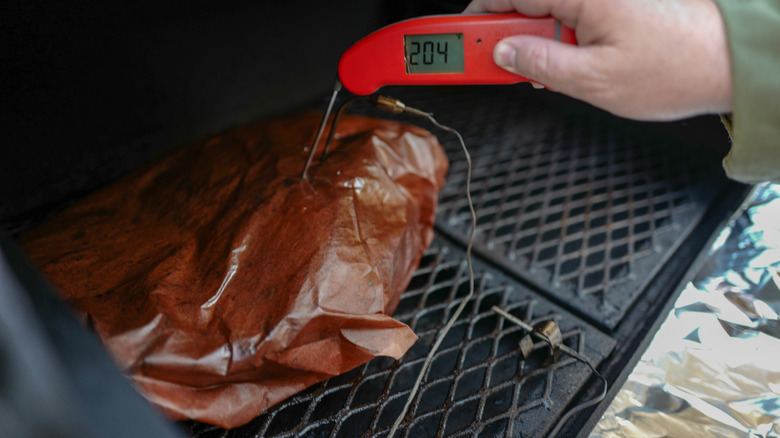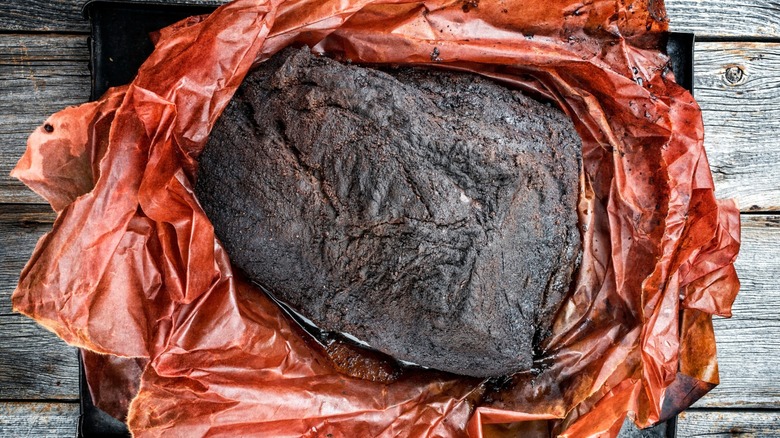How Long Does It Take To Smoke A Brisket?
An expertly smoked brisket is a barbecued meat that's held above the rest of the pack. The mouthwateringly tender, juicy texture with just the right amount of smoky flavor always satisfies a craving for BBQ, but it takes some time to prepare. This time commitment varies depending on the overall weight of the meat, as well as some other factors, but an average-sized brisket (10 to 16 pounds) could require you to have your smoker running for the better part of a day. It's commonly known that when cooking this protein you want to go low and slow — which is why you don't want to cook brisket on the grill – but this reliable adage doesn't explain exactly how long it takes to finish this beautiful cut of beef.
Most pit masters recommend smoking brisket at 225 degrees Fahrenheit, and with this temperature as a basis, it becomes easy to estimate a time frame. As a rule, every pound of beef needs to be smoked for one and a half hours to two hours at this temperature, meaning a 10-pound packer will take 15 to 20 hours to cook, and a 16-pound unit takes at least 24 hours. Monitoring the protein with a meat thermometer will let you know when it has achieved perfection, but when it reaches 165 degrees, you will want to take an additional step so your brisket doesn't take longer than it needs to.
When the internal temp begins to stall, wrap it
After your brisket has been in the smoker for some time — or a stove top smoke box if you don't own a bonafide smoker — you will notice the constant rise of the internal temperature beginning to stall. At this point the meat has sweated out so much of its juices that it has cooled itself down, a process known as evaporative cooling. It generally happens as the meat reaches 165 degrees on the inside, but it can occur sooner at 150 degrees or lower in some cases. This cooling extends your cooking time, but there is a way to combat this.
When the temperature of the meat starts to stall, take it out of the smoker and wrap the brisket — a technique known as the Texas Crutch. You can use foil or butcher paper if you have any around, but whichever you use, make sure to completely encase the entire brisket so the juices aren't able to evaporate. You want to do this as soon as the meat begins to stall because the sooner you wrap it up, the sooner your brisket will be done. Once it reaches its final temperature of about 200 degrees Fahrenheit– when the connective tissues have fully rendered — you need to take one final step to ensure all that time nursing your cut didn't go to waste.
Use the faux Cambro technique to rest the brisket
Once you've spent sometimes an entire day smoking a brisket, you are probably more than ready to dig in — but don't cut into it right away. Just like you want to let a steak sit after pulling it off the grill, a brisket needs resting time before it's ready to serve. If you get overzealous and cut into it as soon as it comes out of the smoker, it will almost certainly leave you with a dryer, tougher piece of meat than you anticipated after all that time.
The best method of letting a brisket rest is to re-wrap it in foil and set it on a heat-safe surface with a towel draped over it. This technique — sometimes called the "faux Cambro" method — holds the temperature and allows the muscle fibers within the protein to relax as the juices work their way back into the beef. You want to rest the meat for at least one hour, so you will want to factor that into your overall cooking time when estimating how long it will take to have a completed dish. It may take a while, but once you taste this longtime Hanukkah centerpiece after giving it an appropriate period to cook, you'll be thankful you were patient and gave your brisket all the time it needed.


